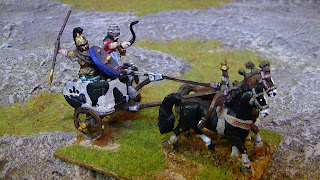This is one of the armies of my son Antoine.
This army is intended to be used as a Minoan force. It is also sometimes aligned as a Mycenaean army.
 |
| Photo: Koryvantes reenacting group |
The Minoan civilization developed on the islands of Crete and Santorini in the south of Greece from 2700 to 1200 BC. AD ..
Drawing its modern name from the legendary king Minos, it was revealed by the English archaeologist Arthur John Evans in the early twentieth century. It is not known by what name she designated herself, but the Egyptians of antiquity called it "Kaphti"
Drawing its modern name from the legendary king Minos, it was revealed by the English archaeologist Arthur John Evans in the early twentieth century. It is not known by what name she designated herself, but the Egyptians of antiquity called it "Kaphti"
Around 2000 BC AD, are built buildings large enough to deserve the name of palace. These constructions are the main change from the Middle Bronze Age. Their foundation results in a concentration of power in certain centers, dictated both by external events and as a consequence of internal economic and social evolution. Written sources from the peoples of the East indicate that the Aegean and Minor Asia experienced an upheaval provoking a reaction from the Cretans. They apparently chose to gather under the rule of a chief, or even two or four, in order better to combat the dangers of external powers. The first palaces of Knossos, Phaistos and Malia are located on the most fertile plains of the island, enabling their owners to accumulate riches, especially agricultural ones, as evidenced by the department stores for agricultural products found in these palaces. Palaces become centers of radiation for 600 to 700 years, and civilization is now considered palatial.
The location of these palaces corresponds to the large agglomerations which existed during the third pre-palatial phase20. Knossos controlled the rich region of north-central Crete, Phaistos dominated the plain area of Messara, and Malia the center-east until present-day Ierapetra. In recent years, archaeologists have spoken of well-defined territories or states, a new phenomenon in Greek space.
The civilization of protopalatial period extends to all Crete. Relations between local leaders seem peaceful and based on collaboration. But the palaces testify to the existence of a central political power and a hierarchy dominated by a king. The execution of major works such as the leveling of the hill at Knossos or Phaistos are indications that the Minoans had already established a division of labor and had a large number of workers. The slavery and the corvee already practiced in the East probably existed also in Crete. The presence of a hierarchy in the palaces is attested by the quantity of seals discovered at Phaistos. Finally, the development of hieroglyphic writing and the appearance of the first linear script would be linked to the bureaucratic system and the need for better control of the inputs and outputs of goods.
The civilization of protopalatial period extends to all Crete. Relations between local leaders seem peaceful and based on collaboration. But the palaces testify to the existence of a central political power and a hierarchy dominated by a king. The execution of major works such as the leveling of the hill at Knossos or Phaistos are indications that the Minoans had already established a division of labor and had a large number of workers. The slavery and the corvee already practiced in the East probably existed also in Crete. The presence of a hierarchy in the palaces is attested by the quantity of seals discovered at Phaistos. Finally, the development of hieroglyphic writing and the appearance of the first linear script would be linked to the bureaucratic system and the need for better control of the inputs and outputs of goods.
The radiance of the Minoan culture is now felt outside of Crete. It seems that Knossos has already laid the foundations of the "Minoan thalassocracy." Kamares ceramics were found at Milos, Lerne, Aegina and Kouphonissi. Imports of ceramics in Egypt, Syria, Byblos and Ugarit prove the links between Crete and these countries.
A Pax Minoica seems to reign on the island which is now under the authority of Knossos. One theory is that the Cretan palaces all belonged to the same master who visited them alternately.
About 1700 BC. A great catastrophe destroyed the three great palaces, in all probability an earthquake, which affected several countries of Asia Minor at the same period. Another theory is that there was a conflict between the palaces of which Knossos emerged victorious.
A Pax Minoica seems to reign on the island which is now under the authority of Knossos. One theory is that the Cretan palaces all belonged to the same master who visited them alternately.
About 1700 BC. A great catastrophe destroyed the three great palaces, in all probability an earthquake, which affected several countries of Asia Minor at the same period. Another theory is that there was a conflict between the palaces of which Knossos emerged victorious.































